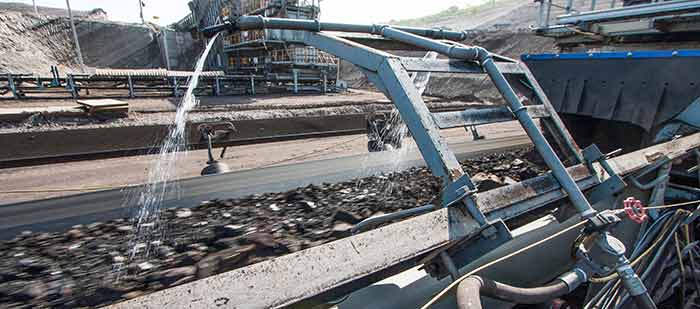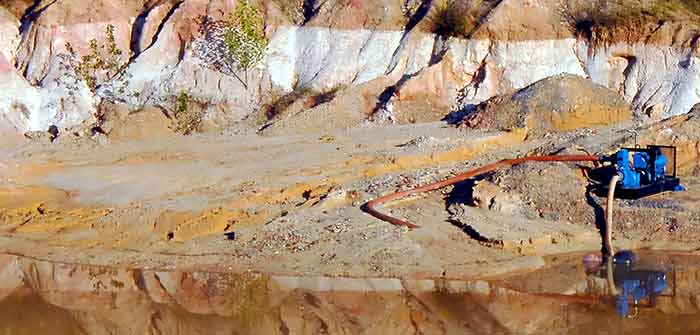
When a foreman calls a company and says, “I need a pump for my mine,” what comes to mind first? What kind of pump does the end user need? Is it slurry, submersible sump, gland water, metering, plant water supply, dewatering, a dust suppression pump or a booster pump? Obviously, there are many pump applications on nearly every mine site, and it will take homework to select the right one.
The first question to ask is, “What type of mine is it?” Is it a coal, stone, precious metals mine, or perhaps a sand operation? Second, is it an underground mine, a surface mine or dredging operation? Where is the pumping application located in relation to the mine itself? Once that knowledge is in hand, it is time to focus on the details of the particular application. This, in turn, leads to another set of questions that must be answered in order to provide complete information about each pumping application within the mine.
 Image 1. This is one type of conveyance dust suppression system that is used during the coal mining process to control respirable coal and rock dust. (Images courtesy of Motion Industries)
Image 1. This is one type of conveyance dust suppression system that is used during the coal mining process to control respirable coal and rock dust. (Images courtesy of Motion Industries)Considerations for Proper Mine Dewatering
This article focuses on mine dewatering. Proper mine dewatering is a critical component to every successful mining operation, regardless of the type of mining that is being done.
If the pumps used for dewatering are too small or there is an insufficient number of them, there is a possibility of being flooded out and losing critical equipment and operational time.
Conversely, if the selected dewatering pump is too large, the motor could burn on the pump because of too many starts per hour. The motor will not have time to cool off prior to starting again. Also, the pump could experience suction cavitation, which happens when it is starving for water.
Either way, the result is costly repairs and/or replacements over time.
Some of the most common pumps used for mine dewatering are submersible centrifugal pumps (pump and motor in one unit, all submerged underwater), submersible turbines (pump and motor installed in a well or cooling sleeve and submerged), and vertical turbines, either installed on a float in a pond/lake or in a well (pump end and column pipe submerged with motor mounted on a motor stool above ground/water). Additionally, there are engine-driven centrifugal pumps (mounted on a trailer or skid) or a self-priming centrifugal pump driven by an electric motor. There are pros and cons to each type of pump that must be considered to meet the different requirements for each application.
There are several key factors to consider when selecting a pump for mine dewatering. First, determine the static head that needs to be overcome. If the pump cannot produce enough pressure to overcome the vertical distance, the needed flow will not be achieved.
Second, what flow is needed to properly remove the amount of water in order to keep the mine dry, and what style of pump is most suited for the application? Would it be a self-priming, submersible or a vertical turbine? If self-priming, what is the length of suction line? This determines the friction loss and the height that can be pulled with a suction lift. The size and type of material of the suction line will need to be identified. The size of the suction line must be equal to or greater than the size of the suction or inlet port. This helps reduce the possibility of suction cavitation. The size, length and type of material of the discharge line must be taken into account, as well. All of these items factor into the total dynamic head, which is an important part of proper pump selection.
Another important factor is the consideration of any solids in the water, as this decides what style of impeller and what strainer size to use.
Will an agitator be required for the application? The pH of the water will determine the proper material of construction for the pump and seal.
 Image 2. A dewatering pump is used to remove water from a mining site.
Image 2. A dewatering pump is used to remove water from a mining site. Underground Applications & Submersible Pumps
If it is an underground mining application, determine if this is a Mining Safety and Health Association (MSHA) application. All equipment going into those locations must meet strict criteria for the protection of those working in that environment. System designers must ensure that all of the equipment going into these areas conforms to MSHA standards and requirements.
Most underground dewatering applications use submersible pumps, due to their easy mobility and quick lead times from the factories. There are, however, potential hazards to the ease of changing out submersible pumps.
It is common for a miner to go to the storeroom or warehouse for a replacement pump and grab a pump that is the “required” horsepower (hp). If they have not checked to see if it is a high head (higher pressure) or high flow variation, or worse yet, getting a pump that is not MSHA approved and placing in it an explosive environment—the results can be devastating.
If it is the wrong style, the operator can burn up or deadhead the pump. Either way, this results in lack of performance, which is costly. Quite often, pumps end up lying on the side, covered halfway with a slurry the consistency of pudding, the strainer partially exposed to air—shortening the pump’s life and wasting time and money. The proper placement of the pump is just as important as the proper pump selection.
Users must be careful to select the correct voltage motor and control panel, as many of the pumps are single voltage, not dual voltage. Pump suspension is important so mud and debris are not pulled into the pump, starving the pump for water. At the same time, it needs enough submergence to keep the motor cooled properly and not create a vortex, which will pull air into the pump. It is also helpful to use a control system to keep the pump from running dry. If solids are present, consider using a vortex impeller and other materials of abrasive-resistant construction if the solids are abrasive.
Using a submersible turbine is an efficient way to dewater, as long as the water is free of solids. Be sure the control panel complies with all required certifications. Many submersible turbines are of 304 SST or a polyresin construction, so low pH is not a factor for them. They also have good mechanical efficiencies with a low upfront cost. The downside is that they have to be installed in a well or a cooling sleeve to promote proper motor protection. If they are not installed in a sleeve, the pump may not have adequate cooling for the motor. This will cause premature motor failure.
Aboveground Applications & Self-Priming Pumps
Let’s have another look at self-priming centrifugal pumps, or self-primers, for aboveground dewatering. Common usage would be surface-mining operations (or large-scale underground mining applications) where there are no issues with ventilation. This style of pump can handle various size solids and produce higher flow.
The downside is that they are not as efficient, which causes them to be more costly to run, and they are limited in terms of suction lift.
In real terms, when exceeding about 20 feet of suction lift, the pump performance is greatly affected; therefore, proper pump selection and placement is critical.
The engine-driven models must be carefully selected and properly applied, as there are restrictions in the areas in which they can be used. Be sure to note the environment the pump is to be placed in, and ensure that the selection is in accordance with all safety issues and concerns. Of course, there are other considerations with engine-driven pumps, whether gas or diesel, as the fuel tanks must be filled periodically and fuel costs can be substantial.
Metallurgic Compatibility
Another issue with dewatering mines is low pH, or acidic water. It can wreak havoc on standard cast, ductile iron and aluminum pumps. To avoid this, upgrade the material to a 304, 316 SST, CD4MCU, HC600 or fiberglass. Another option that can be more cost-effective is using specially designed epoxy coating, particularly if long lead times are in place for specialty pumps. Epoxy coatings, when applied properly, reduce corrosion/erosion inside the pump, among other ancillary benefits. The benefits can include hydraulic smoothness and hydrophobicity that allow for high-energy efficiency and optimal pump performance. Testing the groundwater for compatibility with the pump metallurgy is necessary to ensure the longevity of pump equipment.


